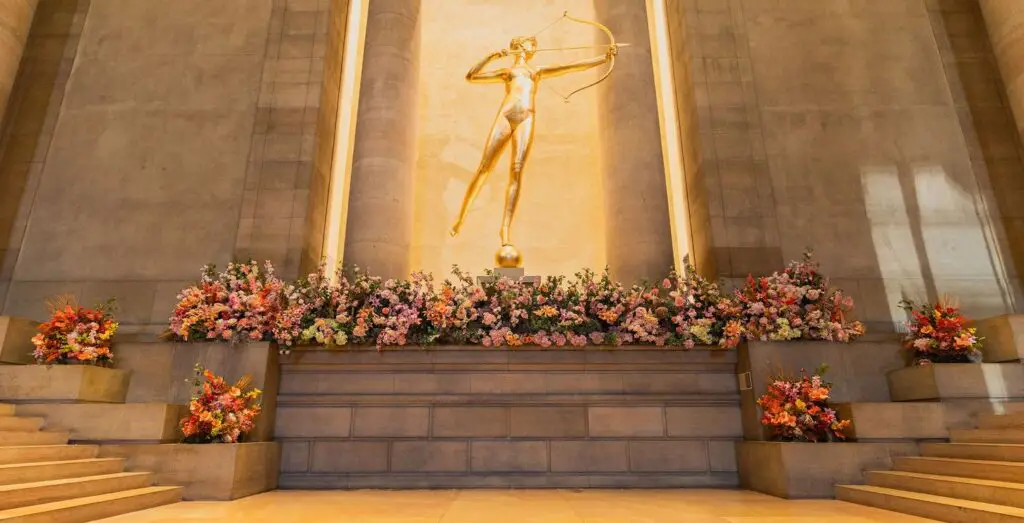Nestled within the heart of Philadelphia, the Philadelphia Museum of Art stands as an architectural marvel and cultural beacon, inviting visitors on a journey through the ages. With its grandeur echoing through the iconic steps immortalized in the film “Rocky,” this museum transcends mere aesthetics; it embodies a rich tapestry of history, artistic expression, and community engagement.
The story begins in 1876, when the museum was founded, marking the centennial celebration of the United States. Since then, it has evolved into one of the nation’s preeminent art institutions, housing an extensive collection that spans continents and centuries. Architect Julian Abele’s masterful design, drawing inspiration from classical architecture, sets the stage for an immersive exploration of human creativity and cultural heritage.
Step into the hallowed halls, and you’ll find yourself surrounded by over 240,000 objects that weave together a narrative as diverse as the art itself. From ancient artifacts to cutting-edge contemporary pieces, the Philadelphia Museum of Art embraces the full spectrum of artistic expression, offering a dynamic and multifaceted experience for every visitor.
This institution is not merely a custodian of art; it’s a catalyst for education and inspiration. Through a commitment to accessible programming, the museum engages with the community, fostering a love for the arts and ensuring that its treasures are not confined within the walls but resonate far beyond. Join us as we delve into the depths of this cultural gem, uncovering its historical roots, diverse collections, and the profound impact it has had on both the local community and the broader world of art enthusiasts.
To learn about previous visitors experience check TripAdvisor (Affiliate Link)
Viator includes the Admission Ticket in it’s The Philadelphia Sightseeing Flex Pass: Save on 35+ Landmark Attractions & Tours offer (Affiliate Link)
Table of Contents
Architectural Marvel
The Philadelphia Museum of Art stands as a testament to architectural brilliance, captivating visitors from the moment they lay eyes on its grand facade. Designed by the distinguished architect Julian Abele, the museum’s structure is a harmonious blend of classical elegance and timeless beauty.
Abele’s vision, influenced by Greek and Roman architectural elements, is most prominently showcased in the museum’s iconic steps—a monumental ascent that has etched itself into the cultural memory of both Philadelphians and global audiences. These steps, immortalized in the legendary training montage of the film “Rocky,” have become an enduring symbol not only of the museum but also of the city itself.
Beyond the famous steps, the building’s exterior boasts a neoclassical aesthetic characterized by graceful columns, intricate detailing, and a sense of symmetry that imparts a regal aura. The sheer scale and majesty of the architecture create a sense of anticipation, inviting visitors to embark on a journey through time and artistry.
As one traverses the interior, the architectural narrative continues to unfold. Each gallery and exhibition space is carefully designed to complement the diverse artworks it houses, creating a symbiotic relationship between form and function. The architectural marvel of the Philadelphia Museum of Art is not merely a backdrop; it is an integral part of the visitor’s immersive experience, enhancing the appreciation of the art within.
In every nook and cranny, from the grand entrance to the quiet corners that house hidden treasures, the architecture serves as a conduit for the museum’s cultural and historical significance. The Philadelphia Museum of Art is not just an art repository; it is a living testament to the enduring impact of thoughtful and inspired architecture on the human spirit.
Historical Roots
The historical roots of the Philadelphia Museum of Art reach deep into the city’s past, intertwining with the rich tapestry of cultural and civic development. Established in 1876 as part of the nation’s centennial celebration, the museum emerged during a pivotal moment in American history, embodying the spirit of progress, artistic exploration, and national identity.
Originally housed in the Centennial Exposition’s Memorial Hall, the museum’s modest beginnings belied the monumental role it would play in shaping the cultural landscape of Philadelphia. As the city evolved, so did the institution, gradually outgrowing its initial space and paving the way for the construction of the iconic main building we recognize today.
The transformative period of the early 20th century saw the appointment of renowned architect Julian Abele, a trailblazing African American architect whose vision significantly contributed to the museum’s architectural identity. Abele’s influence, deeply rooted in classical design principles, added a layer of sophistication to the museum’s structure, elevating it to a symbol of artistic and architectural excellence.
Throughout its history, the Philadelphia Museum of Art has weathered challenges and celebrated triumphs, becoming a cultural hub that mirrors the ebb and flow of Philadelphia’s own narrative. It has welcomed generations of visitors, each era leaving its mark on the museum’s collective identity. Today, as a stalwart guardian of art and culture, the museum stands as a living testament to the enduring power of history, art, and the intrinsic connection between a city and its cultural institutions. The historical roots of the Philadelphia Museum of Art run deep, anchoring it as a vital thread in the fabric of Philadelphia’s vibrant past and promising future.
Diverse Collections
At the heart of the Philadelphia Museum of Art lies an extraordinary treasure trove – a diverse and expansive collection that transcends time, geography, and artistic genres. With over 240,000 objects, the museum’s holdings offer a kaleidoscopic journey through the annals of human creativity.
The European Art collection unveils masterpieces from the Renaissance to the Impressionist era, showcasing the evolution of artistic styles and movements. Visitors can lose themselves in the delicate strokes of a Van Gogh or the grandeur of a Rubens, experiencing firsthand the richness of European artistic heritage.
Venturing further, the American Art collection paints a vivid picture of the nation’s history and cultural evolution. From colonial portraits to contemporary installations, this section encapsulates the diverse narratives that have shaped the American artistic landscape.
The museum’s commitment to global inclusivity is evident in its Asian Art collection, a mesmerizing array of artifacts spanning millennia and representing the intricate tapestry of Asian cultures. Ceramics, paintings, and sculptures offer glimpses into the spiritual and aesthetic dimensions of societies across the continent.
Modern and Contemporary Art, a dynamic and ever-evolving segment, serves as a testament to the museum’s commitment to staying at the forefront of artistic innovation. Here, visitors encounter thought-provoking installations, avant-garde sculptures, and groundbreaking works that challenge traditional notions of art.
The Philadelphia Museum of Art doesn’t merely curate art; it cultivates a dialogue between diverse cultures and periods. African, Latin American, and Middle Eastern art collections, among others, further enrich this cross-cultural conversation, fostering an environment where visitors can explore the interconnectedness of global artistic expressions.
In essence, the museum’s diverse collections aren’t just an assemblage of objects; they represent a celebration of humanity’s collective imagination. As visitors meander through these carefully curated galleries, they embark on a transcendent journey, connecting with the myriad stories, perspectives, and emotions encapsulated within the vast and eclectic embrace of the Philadelphia Museum of Art.
Notable Exhibits and Galleries
Within the labyrinthine corridors of the Philadelphia Museum of Art, a myriad of enchanting exhibits and galleries awaits, each a curated universe of artistic wonders. These spaces not only showcase the depth of the museum’s collection but also provide immersive experiences that transport visitors across time, continents, and artistic movements.
The Rodin Museum, a satellite of the Philadelphia Museum of Art, pays homage to the legendary French sculptor Auguste Rodin. Housing one of the most extensive collections of his works outside of France, this intimate space invites contemplation of iconic sculptures such as “The Thinker” and “The Kiss,” offering a glimpse into Rodin’s revolutionary approach to form and emotion.
The Perelman Building, an architectural gem in its own right, houses a rotating selection of thematic exhibitions. From avant-garde contemporary installations to explorations of specific artists or movements, this space ensures that each visit unveils a new facet of the museum’s diverse collection.
Step into the European Decorative Arts galleries, and you’ll find yourself surrounded by opulent tapestries, exquisite furniture, and ornate objects that provide a tactile connection to the lifestyles of bygone eras. These galleries are a living testament to the marriage of functionality and artistic expression.
For those seeking respite amidst nature’s beauty, the Anne d’Harnoncourt Sculpture Garden offers a serene escape. Named in honor of the museum’s late director, this outdoor haven features sculptures set against the backdrop of lush greenery, creating a harmonious dialogue between art and nature.
The Modern and Contemporary Art galleries, constantly evolving to reflect the pulse of the contemporary art scene, showcase thought-provoking installations, daring conceptual art, and the boundary-pushing creations of today’s avant-garde artists.
Whether wandering through the grand halls of European masterpieces or exploring the cutting-edge realms of contemporary expression, each exhibit and gallery within the Philadelphia Museum of Art is a curated revelation. They beckon visitors to delve deeper, sparking a profound engagement with the diverse narratives and artistic expressions that collectively define the museum’s identity.
Educational Initiatives
The Philadelphia Museum of Art transcends its role as a repository of art, embracing a robust commitment to education that permeates every aspect of its mission. With a fervent belief in the transformative power of art, the museum has devised a multifaceted array of educational initiatives, ensuring that its treasures serve as dynamic catalysts for learning and inspiration.
At the core of these initiatives are thoughtfully curated programs designed to engage diverse audiences. The museum’s educational workshops cater to visitors of all ages, offering hands-on experiences that foster a deeper understanding of artistic techniques, historical contexts, and cultural significance. From interactive sessions for young learners to specialized workshops for adults, the educational spectrum is as broad and inclusive as the museum’s expansive collection.
Engaging with the local community is a paramount focus. Collaborative partnerships with schools, community centers, and cultural organizations extend the museum’s reach beyond its physical walls. Through outreach programs, the Philadelphia Museum of Art takes art education directly into neighborhoods, promoting accessibility and inclusivity.
A testament to the museum’s commitment to lifelong learning is its roster of lectures, gallery talks, and symposiums. These events provide a platform for scholars, artists, and enthusiasts to delve into nuanced discussions, offering invaluable insights into art history, theory, and contemporary practices.
The museum’s dedication to fostering the next generation of art enthusiasts is evident in its family-friendly initiatives. From specially tailored tours for young visitors to interactive exhibits designed to captivate the imaginations of the littlest art connoisseurs, the museum ensures that learning becomes a joyful and immersive experience for all.
Digital platforms further amplify the educational reach of the Philadelphia Museum of Art. Online resources, virtual tours, and interactive multimedia materials enable global audiences to access the museum’s educational offerings, breaking down geographical barriers and democratizing the art-learning experience.
In essence, the educational initiatives of the Philadelphia Museum of Art weave a vibrant tapestry of knowledge, bridging the gap between the artistic past and the curious minds of the present and future. By fostering a culture of exploration and understanding, these initiatives underscore the museum’s role as not just a custodian of art but as a dynamic hub of inspiration and learning.
Cultural Impact
The Philadelphia Museum of Art stands as a cultural cornerstone, its influence radiating far beyond its architectural walls. Its profound impact on the city of Philadelphia and the broader cultural landscape is a testament to the transformative power of art in shaping identities, fostering community, and leaving an indelible mark on popular consciousness.
In the realm of popular culture, the museum’s iconic steps have become synonymous with resilience and triumph, thanks to their starring role in the film “Rocky.” The image of a triumphant Sylvester Stallone ascending these steps has etched itself into the global imagination, turning the museum into an enduring symbol of determination and accomplishment.
Beyond the cinematic realm, the museum has played a pivotal role in shaping Philadelphia’s identity. It serves as a cultural hub, attracting locals and visitors alike to immerse themselves in the city’s artistic heritage. The museum’s diverse collections, exhibitions, and educational programs contribute to a vibrant cultural tapestry, fostering a sense of pride and connection among Philadelphians.
The Philadelphia Museum of Art is not just a repository of artifacts; it’s a dynamic force for cultural dialogue. Through its commitment to inclusivity, the museum bridges gaps between diverse communities, fostering understanding and appreciation for the myriad voices represented in its collections. This inclusive approach extends to community engagement initiatives that bring art directly into neighborhoods, breaking down barriers and ensuring that cultural enrichment is accessible to all.
On a broader scale, the museum’s influence resonates in the art world. Its exhibitions, featuring everything from classical masterpieces to cutting-edge contemporary works, contribute to the ongoing narrative of human creativity. The museum serves as a stage for emerging artists and a sanctuary for established ones, amplifying their voices and contributing to the ever-evolving discourse of artistic expression.
In essence, the Philadelphia Museum of Art is not merely a cultural institution; it is a dynamic force that weaves itself into the fabric of Philadelphia’s identity and extends its influence globally. Through its cultural impact, the museum ensures that the transformative power of art is not confined within its walls but radiates outward, enriching lives, inspiring minds, and shaping the cultural landscape for generations to come.
Visitor Experience
The visitor experience at the Philadelphia Museum of Art transcends the conventional notion of a museum visit, offering a journey that is immersive, educational, and deeply enriching. From the moment visitors ascend the iconic steps that have become synonymous with the city, a world of artistic wonders unfolds, promising a kaleidoscope of experiences that cater to diverse interests and ages.
The grandeur of the museum’s architectural marvel, designed by Julian Abele, sets the stage for an encounter with cultural treasures from across the globe. As visitors traverse the expansive galleries, each step unveils a carefully curated collection that spans centuries and continents. The European masterpieces, American artifacts, Asian treasures, and contemporary wonders collectively form a narrative that captivates the imagination and invites contemplation.
To enhance the visitor experience, the museum offers a range of guided tours led by knowledgeable docents. These tours provide insights into the historical context, artistic techniques, and intriguing stories behind the masterpieces, offering a more profound connection with the art on display.
Families with young enthusiasts can partake in specially tailored programs and interactive exhibits designed to engage curious minds. The museum’s commitment to fostering a love for art among the younger generation is evident in its family-friendly spaces, where learning becomes a joyful exploration.
For those seeking a moment of tranquility, the Anne d’Harnoncourt Sculpture Garden offers a serene oasis. Nestled within the museum’s grounds, this outdoor sanctuary invites contemplation amid the beauty of carefully placed sculptures and lush greenery, providing a harmonious balance to the indoor art experience.
Practical amenities, including cafés and gift shops, ensure that visitors can savor the entire museum experience. Whether taking a leisurely break to enjoy a culinary treat or browsing for art-inspired souvenirs, these amenities add to the overall comfort and enjoyment of the visit.
The Philadelphia Museum of Art’s commitment to accessibility is reflected in its various programs, ensuring that everyone, regardless of background or ability, can partake in the cultural enrichment it offers. Whether a seasoned art connoisseur or a first-time visitor, the museum’s multifaceted approach to the visitor experience promises a transformative and memorable encounter with the world of art and culture.
Nearby Attractions
Nestled in the vibrant city of Philadelphia, the Philadelphia Museum of Art finds itself surrounded by a tapestry of cultural, historical, and recreational delights. Beyond its iconic steps and grandeur, visitors have the opportunity to explore an array of nearby attractions that complement the museum experience. Whether delving into American history, strolling through picturesque parks, or savoring culinary delights, the city offers a diverse range of experiences that harmonize with the artistic wonders awaiting at the museum.
Nearby Attractions:
- Fairmount Park: Immerse yourself in the natural beauty of Fairmount Park, one of the largest urban green spaces in the country. Boasting scenic trails, historic sites, and serene waterfronts, the park provides a tranquil escape just moments away from the museum’s doorstep.
- Eastern State Penitentiary: Uncover the eerie history of Eastern State Penitentiary, a former prison turned historic site. Explore the haunting cellblocks and learn about the prison’s innovative architectural design that revolutionized the American penitentiary system.
- The Barnes Foundation: Art enthusiasts can extend their cultural exploration by visiting The Barnes Foundation, home to an impressive collection of post-impressionist and early modern paintings. Housed in a unique architectural setting, this institution offers an enriching artistic experience.
- Philadelphia Zoo: For a family-friendly adventure, head to the Philadelphia Zoo, America’s first zoo. Home to a diverse array of animals, interactive exhibits, and educational programs, it promises an engaging and entertaining outing for visitors of all ages.
- Boathouse Row: Along the Schuylkill River, the picturesque Boathouse Row showcases a lineup of charming historic boathouses illuminated at night. Take a leisurely stroll along the riverbank to enjoy this iconic Philadelphia landmark.
- The Franklin Institute: Unleash your inner scientist at The Franklin Institute, a renowned science museum and educational center. Interactive exhibits, planetarium shows, and captivating displays make it a perfect destination for both children and adults.
- Philadelphia’s Historic District: Immerse yourself in the birthplace of the nation by exploring Philadelphia’s Historic District. Walk in the footsteps of the Founding Fathers, visit Independence Hall, and marvel at the iconic Liberty Bell, all within easy reach of the museum.
These nearby attractions complement the cultural allure of the Philadelphia Museum of Art, providing a well-rounded experience that invites visitors to delve into the diverse facets of this historically rich and dynamic city.
Conclusion
In conclusion, the Philadelphia Museum of Art stands as a testament to the intertwining narratives of art, history, and cultural vibrancy. From its iconic steps immortalized in cinema to the vast and diverse collections housed within, the museum offers an unparalleled journey through time and creativity. The architectural grandeur of Julian Abele’s design sets the stage for a cultural exploration that extends far beyond the museum’s physical confines, shaping the identity of both Philadelphia and its visitors.
As one ascends the steps and delves into the myriad galleries, the museum’s impact becomes evident not only in the masterpieces adorning its walls but in the transformative experiences it provides. The commitment to education, the celebration of diverse voices, and the harmonious integration with nearby attractions collectively define the Philadelphia Museum of Art as a cultural epicenter. Whether sparking inspiration, fostering community engagement, or offering a moment of respite in the Sculpture Garden, the museum leaves an indelible mark on those who venture within. It beckons visitors to not only witness the artistic expressions of the past and present but to become active participants in a cultural narrative that continues to unfold, ensuring that the spirit of art endures for generations to come.






4 thoughts on “Artistic Splendor: Exploring the Treasures of the Philadelphia Museum of Art”
Comments are closed.